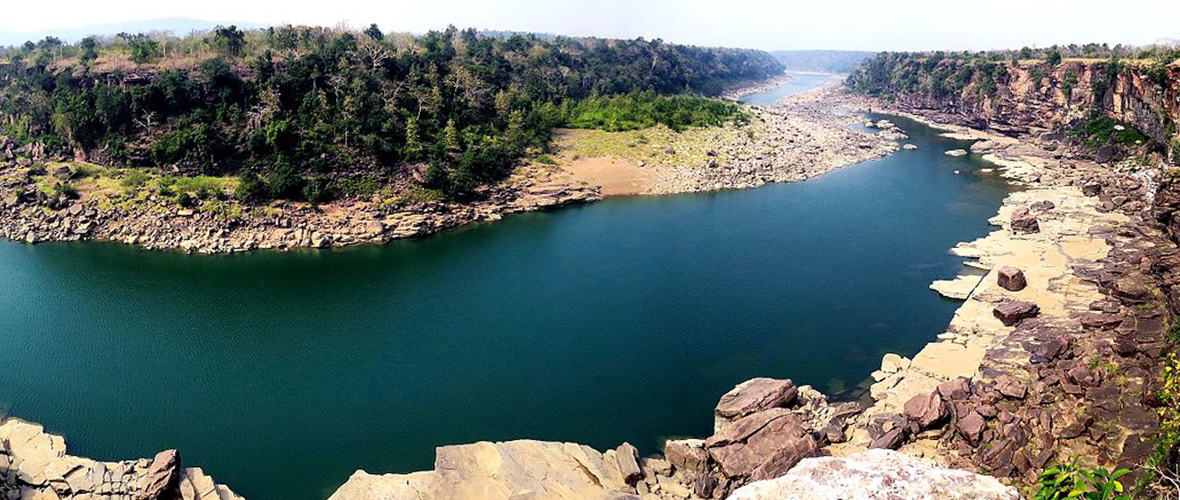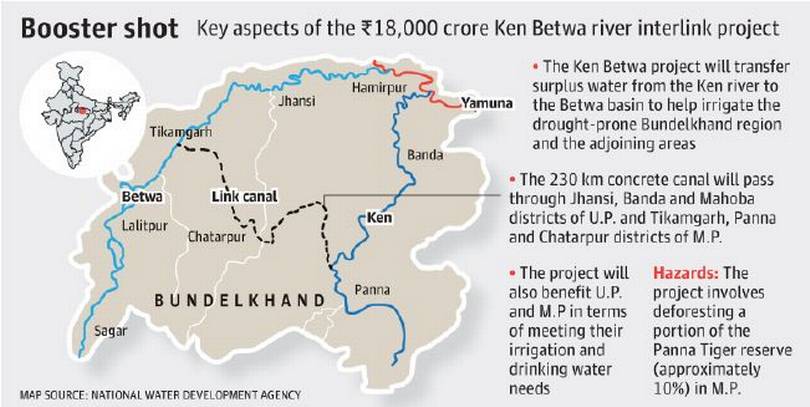A Cure Worse Than the Disease
February 9, 2022 | Expert Insights

The 2022 Union budget has allocated Rs 44,605 crores for the execution of the Ken-Betwa river link project. The Centre also expressed interest in five more river inter-link projects that are in the pipeline, with their draft detailed project reports (DPR) being finalised.
Background
Conceived in the National Perspective Plan drafted by the Ministry of Irrigation in the 1980s, the project sought to augment existing groundwater resourced by connecting water-deficit basins with water-surplus ones. The National Water Development Agency under this Plan has identified 30 interlink projects, of which Ken-Betwa Link Project is one. It, however, gained momentum only when a memorandum was signed between the Centre and the states of Uttar Pradesh and Madhya Pradesh for preparation of DPR in 2005. In 2008, it was taken up as a national project as a part of a relief package to the drought-prone Bundelkhand region.
Both Ken and Betwa are tributaries of the river Yamuna. The project entails bringing water from the ‘surplus’ Ken basin to the ‘deficit’ Betwa basin. The execution has been divided into two phases - phase 1 requires the building of a dam at Dhaudhan village with its subunits and a Ken-Betwa Link Canal. The second phase will entail the construction of Lower Orr Dam (Orr is a tributary of Betwa), integration of the Bina irrigation and multipurpose project (in MP) into the larger river link project and completion of the Kotha Barrage project (in the mid-upper Betwa basin). The objective therein is to irrigate 6.53 lakh hectares of land in Madhya Pradesh, 2.5 lakh hectares in Uttar Pradesh and to provide 62 lakh people access to drinking water.
The collateral benefits from the project include boosting socio-economic prosperity of the backward Bundelkhand region by generating agriculture-based low-cost employment in order to curtail distress migration. It is also envisaged to generate 103 MW of hydropower and 27 MW of solar power.

Analysis
For a project of this scale, the cost-benefit analysis becomes crucial; costs incurred (economic, ecological, social and political) must not outweigh the proposed outcome. Despite the Hon’ble Supreme Court granting permission to the government to proceed with the project in 2014, experts were not convinced. In 2019, the report of the Cabinet Expert Committee (CEC) set up by the Supreme Court resonated with the words of the Environment Minister of India in 2009, who had called the idea of river linking "a human-ecological-economic-disaster".
To begin with, the concept of a ‘surplus’ and a ‘deficit’ basin in itself is vague and has not undergone any expert scrutiny. Both the rivers in question have joint watersheds and experience similar weather patterns throughout the year; hence the classification lacks a basis given that Ken is the smaller of the two. Additionally, Ken is a major river in the Bundelkhand region of Central India - which happens to be a critical drought-prone and water-scarce area - challenging the claim of ‘surplus’ flow in Ken.
The dams which form a major part of the project are likely to submerge a vast mass of ecologically unique ecosystems, which will include a major area of the Panna Tiger Reserve in Madhya Pradesh, cutting off the core tiger habitat from the rest of the national park. According to the CEC report, the project in its entirety is likely to submerge six thousand hectares of forest land, including thousands of hectares of wildlife habitat. It will directly impact the habitat of tigers and jackals in the area and disrupt the ongoing conservation programs for vultures and ghariyals. The re-location of the animals is a costly affair and detrimental to their health and survival.
The vast swathes of land which are likely to be flooded include inhabited areas of central India. The displacement of people will require rehabilitation and resettlement on a very large scale, including the provision of basic amenities, farmlands and livelihoods. The distaste and discomfort of locals were narrated by the members of the committee on interlinking of rivers when they visited the Daudhan village and faced vehement opposition. It is ironic that the people who are the direct ‘beneficiaries’ of the project were neither consulted nor involved in this massive programme.
Another important conclusion drawn in the CEC report is the lack of exploration of alternatives for the problem of water scarcity and drought in the Bundelkhand region. The service area of the inter-link project is largely the upper Betwa basin, which does not entirely fall within the said region. Several target areas like Vidisha and Raisen are also outside Bundelkhand. Most of these areas are already within the service range of other irrigation, and canal projects and hence the relief package under which the river link project is being advocated does not justify its stated purpose.
Assessment
- It is a well-known fact that mega river link projects come at a huge ecological and economic cost, especially to the region that has to give up its home and hearth to make such huge projects a reality. It is, therefore, for the state to do a very detailed and in-depth study of the cost-to-benefit ratio by involving locals, civic activists, subject matter experts before a conclusive decision is taken. The long-term impact of such projects makes it important that a holistic view be taken rather than one that is through a monochromatic lens.
- There are many other alternatives to resolve the issue of depleting groundwater tables. A cheaper and ecologically less damaging option, being advocated globally, is improving water efficiency and conservation. In the Indian context, adopting a scientifically sound method of crop selection for areas facing water distress could by itself considerably alter the water use pattern and help augment the water table.
- A project of this scale would require an independent audit by expert hydrologists, ecologists and environmentalists. In addition, plans for resettlement and rehabilitation of people and animals have to be in place and ready for execution before the construction of link canals, dams etc., can begin.








Comments